翻译技巧--增词法与省译法
- 格式:ppt
- 大小:220.00 KB
- 文档页数:31
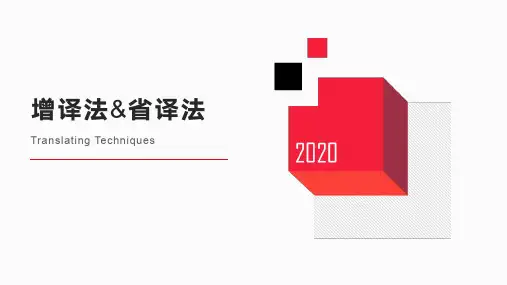
Translating Techniques增译法&省译法u增词法就是在翻译时根据意义上或修辞上或句法上的需要增加原文中虽无其词但有其义的一些词。
u增词绝不是无中生有,不是随意增加原文没有的意义。
u Some metals are easy to machine; others are not.一些金属容易加工,而另一些却。
south.u你也许感到好奇,为什么磁铁的极指向南北呢?u增译的原则:不可添意,适可而止u You may wonder why the magnet's poles point north an1.Reading makes a full man; conference a ready man; and writingan exact man.2.We don’t regret, we never have and never will.3.After the basketball, he still has an important conference.1. Reading makes a full man; conference a ready man; and writing an exact man.读书充实,讨论机智,笔记(写作)使人准确。
2. We don’t regret, we never have and never will.我们不会后悔,我们从来没有,我们将来也不会。
3. After the basketball, he still has an important conference.看完篮球比赛之后,他还有一个重要会议。
1.With what enthusiasm the Chinese people are building socialism!2.The crowds melted away.3.As he sat down and began talking, words poured out.4.She lingered long over his letter.With what enthusiasm the Chinese people are building socialism! 中国人民正以热情建设社会主义啊!The crowds melted away.人群散开了。
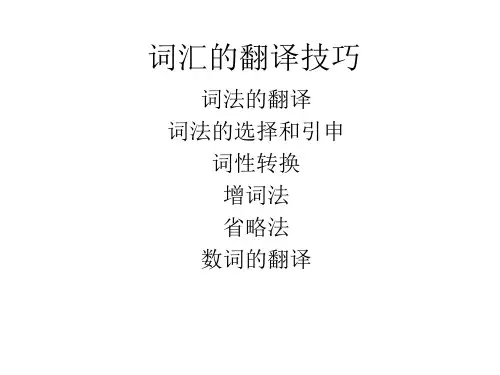
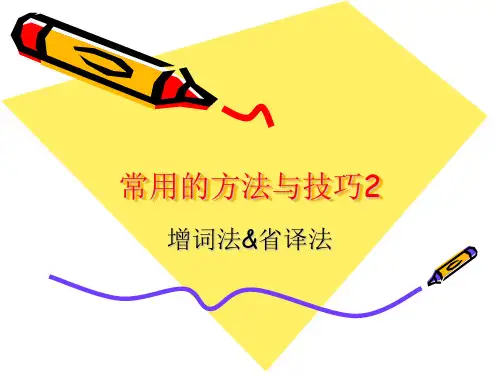
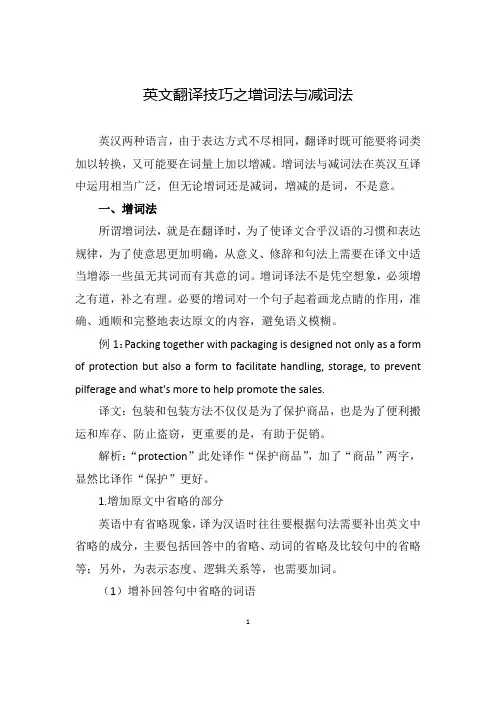
英文翻译技巧之增词法与减词法英汉两种语言,由于表达方式不尽相同,翻译时既可能要将词类加以转换,又可能要在词量上加以增减。
增词法与减词法在英汉互译中运用相当广泛,但无论增词还是减词,增减的是词,不是意。
一、增词法所谓增词法,就是在翻译时,为了使译文合乎汉语的习惯和表达规律,为了使意思更加明确,从意义、修辞和句法上需要在译文中适当增添一些虽无其词而有其意的词。
增词译法不是凭空想象,必须增之有道,补之有理。
必要的增词对一个句子起着画龙点睛的作用,准确、通顺和完整地表达原文的内容,避免语义模糊。
例1:Packing together with packaging is designed not only as a form of protection but also a form to facilitate handling, storage, to prevent pilferage and what's more to help promote the sales.译文:包装和包装方法不仅仅是为了保护商品,也是为了便利搬运和库存、防止盗窃,更重要的是,有助于促销。
解析:“protection”此处译作“保护商品”,加了“商品”两字,显然比译作“保护”更好。
1.增加原文中省略的部分英语中有省略现象,译为汉语时往往要根据句法需要补出英文中省略的成分,主要包括回答中的省略、动词的省略及比较句中的省略等;另外,为表示态度、逻辑关系等,也需要加词。
(1)增补回答句中省略的词语1例2:—He doesn’t know, does he?—Yes, he does.译文:——他不知道吧?——不,他知道。
例3:—Did you enjoy your time in Beijing?—Yes, I did.译文:——你在北京过得愉快吗?——是的,我过得很愉快。
(2)增补并列结构中省略的词语例4:On average, the economy performs less well in a president's second term than in his first.That pattern probably does not apply to Mr Obama. Since his first term was so difficult, the next, by rights, ought to be better.译文:一般来说,美国总统第二个任期内的经济不如第一任期。
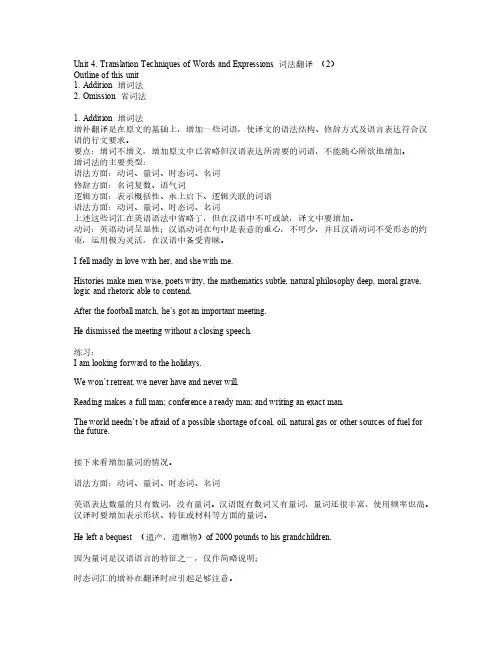
Unit 4. Translation Techniques of Words and Expressions 词法翻译(2)Outline of this unit1. Addition 增词法2. Omission 省词法1. Addition 增词法增补翻译是在原文的基础上,增加一些词语,使译文的语法结构、修辞方式及语言表达符合汉语的行文要求。
要点:增词不增义,增加原文中已省略但汉语表达所需要的词语,不能随心所欲地增加。
增词法的主要类型:语法方面:动词、量词、时态词、名词修辞方面:名词复数、语气词逻辑方面:表示概括性、承上启下、逻辑关联的词语语法方面:动词、量词、时态词、名词上述这些词汇在英语语法中省略了,但在汉语中不可或缺,译文中要增加。
动词:英语动词呈显性;汉语动词在句中是表意的重心,不可少,并且汉语动词不受形态的约束,运用极为灵活,在汉语中备受青睐。
I fell madly in love with her, and she with me.Histories make men wise, poets witty, the mathematics subtle, natural philosophy deep, moral grave, logic and rhetoric able to contend.After the football match, he’s got an important meeting.He dismissed the meeting without a closing speech.练习:I am looking forward to the holidays.We won’t retreat, we never have and never will.Reading makes a full man; conference a ready man; and writing an exact man.The world needn’t be afraid of a possible shortage of coal, oil, natural gas or other sources of fuel for the future.接下来看增加量词的情况。

翻译技巧1翻译技巧(上)一、增译法增词(译)法就是指在翻译时按照修辞句法上的需要在译文中增加一些原文中虽无但有其意的词。
增译的目的是为了更加忠实通顺地表达原文的内容,而决不是无中生有地随意增加。
(一)英译汉常用的增益法I.增加原文中省略的部分1.Since the first test of the atomic bomb the world has learnt that the atom can be splitand its power used. (power后省略了can be)自从第一颗原子弹试验以来,全世界都已知道,原子可以分裂,原子能可以利用。
2. A fool and his words are soon parted; a man of genius and his money.(money后省略了are soon parted)愚人会很快忘记说过的话,智者会很快放弃手里的钱。
3.Both human and cow milk are naturally spiced with a small amount of morphine.(human后省略了milk)人乳与牛乳均含有少量吗啡。
4.So-called convenience and frozen foods are now as popular in Europe asthey are in America.如今,所谓的方便食品和速冻食品风靡欧洲,就像在美国一样大众化。
II.增加意义上或修辞上的需要的部分1.He left without a word.他一句话也不说就走了。
2.What a leader he was!他真是一个出类拔萃的领袖啊。
3.Personal tragedy haunted his entire life, in the deaths of loved ones.亲人的相继离世是他的一生充满了个人悲剧。
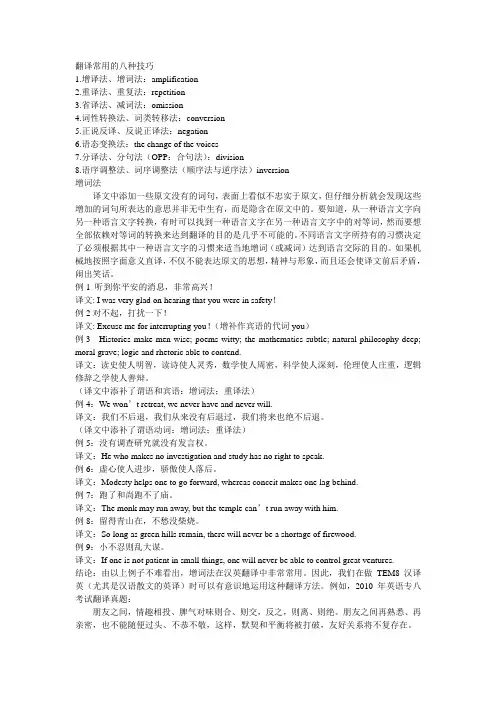
翻译常用的八种技巧1.增译法、增词法:amplification2.重译法、重复法:repetition3.省译法、减词法:omission4.词性转换法、词类转移法:conversion5.正说反译、反说正译法:negation6.语态变换法:the change of the voices7.分译法、分句法(OPP:合句法):division8.语序调整法、词序调整法(顺序法与逆序法)inversion增词法译文中添加一些原文没有的词句,表面上看似不忠实于原文,但仔细分析就会发现这些增加的词句所表达的意思并非无中生有,而是隐含在原文中的。
要知道,从一种语言文字向另一种语言文字转换,有时可以找到一种语言文字在另一种语言文字中的对等词,然而要想全部依赖对等词的转换来达到翻译的目的是几乎不可能的。
不同语言文字所持有的习惯决定了必须根据其中一种语言文字的习惯来适当地增词(或减词)达到语言交际的目的。
如果机械地按照字面意义直译,不仅不能表达原文的思想,精神与形象,而且还会使译文前后矛盾,闹出笑话。
例1 听到你平安的消息,非常高兴!译文: I was very glad on hearing that you were in safety!例2对不起,打扰一下!译文: Excuse me for interrupting you!(增补作宾语的代词you)例3 Histories make men wise; poems witty; the mathematics subtle; natural philosophy deep; moral grave; logic and rhetoric able to contend.译文:读史使人明智,读诗使人灵秀,数学使人周密,科学使人深刻,伦理使人庄重,逻辑修辞之学使人善辩。
(译文中添补了谓语和宾语:增词法;重译法)例4:We won’t retreat, we never have and never will.译文:我们不后退,我们从来没有后退过,我们将来也绝不后退。
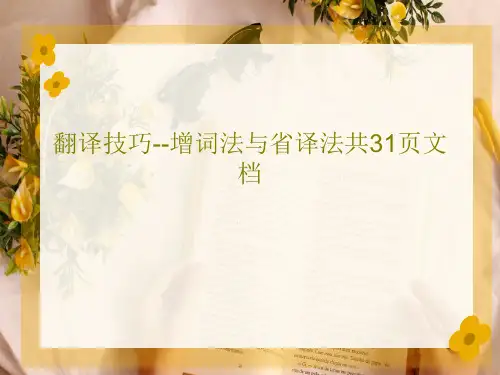

浅谈增词法、省略法在英汉翻译中的技巧李凯玉A Study of Amplification and Omittion inEnglish-Chinese Translation SkillsLi Kaiyu摘要:文字的增补与省略,并不是说在原文思想内容之外,再增加什么意思或减少什么意思,而是说,在保证译文和原文意思完全一致的前提下,在字面上作一些补充或删减,其目的是使译文更加真实流畅。
在翻译中,有些词在特定词组中失去具体实义,仅仅表明范畴,想“态势”、“状态”、“问题”、“局面”等,按我们汉语的搭配习惯,组成“以实带虚”相对的固定词组。
象“衣食住行问题”、“听天由命的心态”、“贫穷落后的状况”等。
英语和汉语表达方式不一样,他习惯使用抽象名词来表达与汉语词组相同的意思,所以翻译的时候要注意。
关键要根据上下文,确定这些词在句子里是否具有实在的意义,则省略不译,以免产生累赘。
这是最忌讳的!关键词:增词;省略;翻译Abstract: With the addition of the words omitted, it does not mean that the original ideological content, the increase or decrease in the meaning of what it meant, It said that to ensure translations and the original meaning is fully consistent with the premise that literally make some additions or delete. The purpose is true: more fluent. In translation, some words have lost their specific real justice in a particular phrase, merely indicates areas like "ours" and "state" "problems" and "situation", according to our customary mix of Chinese, "which in real modest" relative to the fixed phrase. Like "green" and "fatalistic mentality," and "the situation of poverty and backwardness." English and Chinese expression is not, he used abstract terms with the Chinese phrase to express the same meaning. Therefore, we must pay attention to the translation. The key to the light of the context, the possibility of determining these words have real meaning of the sentence., it cannot be translated. In order to avoid cumberance. This is the most taboo!Key words:Amplification; Omitted; Translation引言翻译是一种跨越时空的语言活动,是“一种语言已经表达出来的东西用另一种语言完整而准确的表达出来。
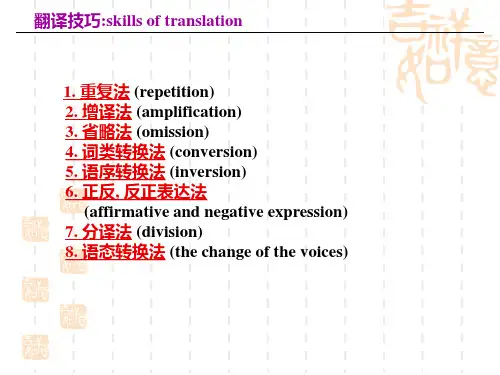
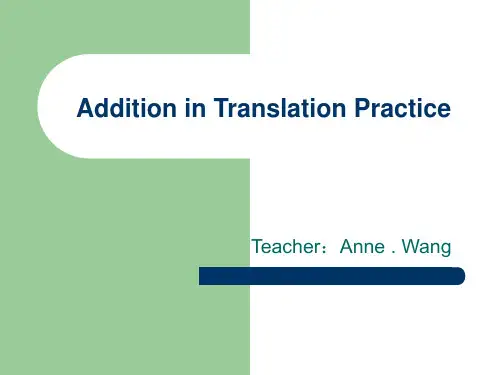
浅析增补法英语翻译技巧(1)增词1)增加名词经典例题: According to scientists,it takesnature500years to create an inch of topsoil. 参照译文: 依据科学家们的看法,自然界要用500年的时间才干形成一英寸厚的表面土壤。
2)增加动词经典例题: In the evening,after the banquets,the concerts and the table tennis exhibitions,he would work on the drafting of the final communiqu.参照译文: 晚上在参加宴会,出席音乐会,观看乒乓球表演之后,他还得草拟最后公告。
(2)逻辑加词1)增加连接词经典例题: Could you imagine what a fool I would make myself without that sum of money on me? 参照译文你能想象我要是身上没带那笔钱,该显得多傻吗?2)增加承上启下的词经典例题: Yes,I like Chinese food. Lots of people do thesedays,sort of the fashion. 参照译文: 不错,我喜爱中国菜。
现在很多人喜爱中国菜,这种状况算是有点赶时髦吧!2英语翻译技巧一.增译法指依据英汉两种语言不同的思维方式、语言习惯和表达方式,在翻译时增添一些词、短句或句子,以便更准确地表达出原文所包涵的意义。
这种方式多半用在汉译英里。
汉语无主句较多,而英语句子一般都要有主语,所以在翻译汉语无主句的时候,除了少数可用英语无主句、被动语态或There be结构来翻译以外,一般都要依据语境补出主语,使句子完整。
英汉两种语言在名词、代词、连词、介词和冠词的使用方法上也存在很大差别。
英语中代词使用频率较高,凡说到人的器官和归某人所有的或与某人有关的事物时,必须在前面加上物主代词。